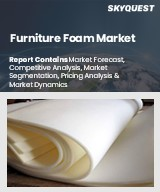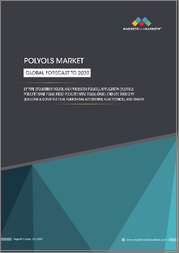
|
시장보고서
상품코드
1627957
스프레이 폴리우레탄 폼 시장 기회, 성장 촉진요인, 산업 동향 분석, 예측(2024-2032년)Spray Polyurethane Foam Market Opportunity, Growth Drivers, Industry Trend Analysis, and Forecast 2024 - 2032 |
||||||
세계 스프레이 폴리우레탄 폼(SPF) 시장은 2023년 47억 달러로 평가되며, 2024년부터 2032년까지 연평균 4.6% 성장할 것으로 예상됩니다.
세계 인구 증가와 급속한 도시화는 주요 성장 촉진요인으로 건설 활동에 대한 수요를 촉진하고 있습니다. 도시 지역이 확대됨에 따라 단열, 기밀, 방수성이 우수한 SPF와 같은 에너지 효율이 높은 건축자재에 대한 수요가 증가하고 있습니다. 이러한 특성으로 인해 SPF는 특히 지속가능성과 에너지 효율이 중요시되는 도시 환경에서 신축 및 개보수 프로젝트 모두에서 선호되는 선택이 되고 있습니다.
SPF는 우수한 단열 효과를 발휘하여 냉난방 비용을 낮추어 에너지 소비를 줄이는 데 크게 기여합니다. 지속가능한 건설 방법이 대중화됨에 따라 에너지 효율 목표를 달성하기 위한 SPF의 역할이 점점 더 중요해지고 있습니다. 또한, 오래된 건물을 최신 에너지 표준에 맞게 개조하는 추세가 강화되고 있는 것도 시장을 더욱 견인하고 있습니다. 또한, 그린 빌딩 인증과 엄격한 에너지 규범의 채택은 주거, 상업 및 산업 분야에서 SPF에 대한 수요를 증가시키고 있습니다.
오픈셀 스프레이 폴리우레탄 폼 분야는 연평균 5%의 성장률을 보이며 2032년까지 42억 달러에 달할 것으로 예상됩니다. 오픈 셀 SPF는 비용 효율성, 다용도성 및 우수한 공기 장벽을 제공하는 능력으로 인해 인기를 얻고 있습니다. 팽창 능력으로 틈새와 균열을 효과적으로 밀봉하여 에너지 효율을 높이고 난방 및 냉방 비용을 절감할 수 있습니다. 따라서 특히 주거용 및 경상업용 단열재에 적합합니다.
| 시장 범위 | |
|---|---|
| 시작 연도 | 2023년 |
| 예측 연도 | 2024-2032 |
| 시작 금액 | 47억 달러 |
| 예상 금액 | 70억 달러 |
| CAGR | 4.6% |
이액형 고압 스프레이 폼 시스템은 우수한 단열 특성과 내구성으로 시장을 장악하고 있으며, 2032년까지 32억 달러의 매출을 달성할 것으로 예상됩니다. 이 시스템은 고압 하에서 이소시아네이트와 폴리올 수지를 결합하여 높은 R값을 가진 이음새가 없는 기밀 장벽을 생성합니다. 빠른 도포와 견고한 열 성능으로 에너지 효율이 높은 건설 프로젝트에 적합하며, 단열재의 수명을 연장하고 에너지 손실을 줄입니다.
미국의 스프레이 폴리우레탄 폼 시장은 2032년까지 10억 달러에 달할 것으로 예상됩니다. 정부의 장려책과 규제에 힘입어 에너지 효율이 높은 건축자재에 대한 미국의 높은 관심은 큰 성장 동력이 되고 있습니다. 지속가능한 건축을 장려하는 프로그램과 견조한 주택 시장 및 상업용 공간에 대한 수요와 함께 에너지 효율을 개선하기 위한 신축 및 개보수 프로젝트 모두에서 SPF의 사용을 촉진하고 있으며, SPF의 채택은 에너지 절약 목표에 부합하고 최신 건설 전략의 핵심 요소로 자리 잡고 있습니다. 중요한 요소입니다.
목차
제1장 조사 방법과 조사 범위
제2장 주요 요약
제3장 업계 인사이트
- 생태계 분석
- 밸류체인에 영향을 미치는 요인
- 이익률 분석
- 파괴
- 향후 전망
- 제조업체
- 유통업체
- 공급업체 상황
- 이익률 분석
- 규제 상황
- 영향요인
- 성장 촉진요인
- 인구 증가와 급속한 도시화
- 스포츠·레저 산업의 수요 확대
- 업계의 잠재적 리스크와 과제
- 엄격한 정부 규제
- 유리섬유나 셀룰로오스 단열 솔루션과의 경쟁 격화
- 성장 촉진요인
- 성장 가능성 분석
- Porters 분석
- PESTEL 분석
제4장 경쟁 구도
- 소개
- 기업 점유율 분석
- 경쟁 포지셔닝 매트릭스
- 전략 전망 매트릭스
제5장 시장 추정과 예측 : 유형별, 2021-2032년
- 주요 동향
- 오픈 셀
- 클로즈드 셀
제6장 시장 추정과 예측 : 제품별, 2021-2032년
- 주요 동향
- 2액형 고압 스프레이 폼
- 원 컴포넌트 폼(OCF)
- 2액형 저압 스프레이 폼
- 기타
제7장 시장 추정과 예측 : 용도별, 2021-2032년
- 주요 동향
- 단열
- 방수
- 석면 봉지
- 실란트
- 기타 용도
제8장 시장 추정과 예측 : 지역별, 2021-2032년
- 주요 동향
- 북미
- 미국
- 캐나다
- 유럽
- 영국
- 독일
- 프랑스
- 이탈리아
- 스페인
- 러시아
- 아시아태평양
- 중국
- 인도
- 일본
- 한국
- 호주
- 라틴아메리카
- 브라질
- 멕시코
- 중동 및 아프리카
- 남아프리카공화국
- 사우디아라비아
- 아랍에미리트
제9장 기업 개요
- Accella Corporation
- BASF SE
- CertainTeed
- Dow
- Huntsman
- Icynene-Lapolla
- Invista
- Isothane Ltd.
- Johns Manville
- LyondellBasell Industries
- NCFI Polyurethanes
- Rogers Corporation
- Sekisui Chemical Co. Ltd.
- Soprema
- Specialty Products Inc.
The Global Spray Polyurethane Foam Market was valued at USD 4.7 billion in 2023 and is anticipated to grow at a CAGR of 4.6% from 2024 to 2032. The increasing global population and rapid urbanization are major growth drivers, fueling demand for construction activities. As urban areas expand, the need for energy-efficient building materials like SPF rises, given its effectiveness in insulation, air sealing, and waterproofing. These characteristics make SPF a preferred choice for both new construction and renovation projects, especially in urban environments where sustainability and energy efficiency are critical.
SPF contributes significantly to reducing energy consumption by providing superior thermal insulation, which lowers heating and cooling costs. As sustainable construction practices gain traction, SPF's role in meeting energy-efficiency goals has become increasingly prominent. Additionally, the growing trend of retrofitting older structures to align with modern energy standards is further driving the market. The adoption of green building certifications and stringent energy codes has also increased the demand for SPF across residential, commercial, and industrial applications.
The open-cell spray polyurethane foam segment is projected to grow at a CAGR of 5% and reach USD 4.2 billion by 2032. Open-cell SPF is gaining popularity due to its cost-effectiveness, versatility, and ability to provide excellent air barriers. Its expansion capability allows it to seal gaps and cracks effectively, improving energy efficiency and reducing heating and cooling costs. This makes it particularly suitable for insulation in residential and light commercial settings.
| Market Scope | |
|---|---|
| Start Year | 2023 |
| Forecast Year | 2024-2032 |
| Start Value | $4.7 Billion |
| Forecast Value | $7 Billion |
| CAGR | 4.6% |
The two-component high-pressure spray foam system is expected to generate USD 3.2 billion by 2032, dominating the market with its superior insulation properties and durability. This system combines isocyanate and polyol resin under high pressure, producing a seamless, airtight barrier with high R-values. Its quick application and robust thermal performance make it ideal for energy-efficient construction projects, ensuring long-lasting insulation and reduced energy loss.
U.S. spray polyurethane foam market is projected to reach USD 1 billion by 2032. The country's strong focus on energy-effective building equipment, supported by government incentives and regulations, is a significant growth driver. Programs promoting sustainable construction, along with the robust housing market and demand for commercial spaces, are propelling SPF usage in both new builds and retrofitting projects aimed at improving energy efficiency. The adoption of SPF aligns with energy conservation goals, making it a critical component of modern construction strategies.
Table of Contents
Chapter 1 Methodology & Scope
- 1.1 Market scope & definitions
- 1.2 Base estimates & calculations
- 1.3 Forecast calculations
- 1.4 Data sources
- 1.4.1 Primary
- 1.4.2 Secondary
- 1.4.2.1 Paid sources
- 1.4.2.2 Public sources
Chapter 2 Executive Summary
- 2.1 Industry synopsis, 2021-2032
Chapter 3 Industry Insights
- 3.1 Industry ecosystem analysis
- 3.1.1 Factor affecting the value chain
- 3.1.2 Profit margin analysis
- 3.1.3 Disruptions
- 3.1.4 Future outlook
- 3.1.5 Manufacturers
- 3.1.6 Distributors
- 3.2 Supplier landscape
- 3.3 Profit margin analysis
- 3.4 Regulatory landscape
- 3.5 Impact forces
- 3.5.1 Growth drivers
- 3.5.1.1 Growing population and rapid urbanization
- 3.5.1.2 Growing demand from sport and leisure industry
- 3.5.2 Industry pitfalls & challenges
- 3.5.2.1 Stringent Government Regulations
- 3.5.2.2 Growing Competition from Fiberglass and Cellulose Insulation Solutions
- 3.5.1 Growth drivers
- 3.6 Growth potential analysis
- 3.7 Porter's analysis
- 3.8 PESTEL analysis
Chapter 4 Competitive Landscape, 2023
- 4.1 Introduction
- 4.2 Company market share analysis
- 4.3 Competitive positioning matrix
- 4.4 Strategic outlook matrix
Chapter 5 Market Estimates & Forecast, By Type, 2021-2032 (USD Billion) (Kilo Tons)
- 5.1 Key trends
- 5.2 Open cell
- 5.3 Closed cell
Chapter 6 Market Estimates & Forecast, By Product, 2021-2032 (USD Billion) (Kilo Tons)
- 6.1 Key trends
- 6.2 Two-component high-pressure spray foam
- 6.3 One Component Foam (OCF)
- 6.4 Two-component low-pressure spray foam
- 6.5 Others
Chapter 7 Market Estimates & Forecast, By Application, 2021-2032 (USD Billion) (Kilo Tons)
- 7.1 Key trends
- 7.2 Insulation
- 7.3 Waterproofing
- 7.4 Asbestos encapsulation
- 7.5 Sealant
- 7.6 Other applications
Chapter 8 Market Estimates & Forecast, By Region, 2021-2032 (USD Billion) (Kilo Tons)
- 8.1 Key trends
- 8.2 North America
- 8.2.1 U.S.
- 8.2.2 Canada
- 8.3 Europe
- 8.3.1 UK
- 8.3.2 Germany
- 8.3.3 France
- 8.3.4 Italy
- 8.3.5 Spain
- 8.3.6 Russia
- 8.4 Asia Pacific
- 8.4.1 China
- 8.4.2 India
- 8.4.3 Japan
- 8.4.4 South Korea
- 8.4.5 Australia
- 8.5 Latin America
- 8.5.1 Brazil
- 8.5.2 Mexico
- 8.6 MEA
- 8.6.1 South Africa
- 8.6.2 Saudi Arabia
- 8.6.3 UAE
Chapter 9 Company Profiles
- 9.1 Accella Corporation
- 9.2 BASF SE
- 9.3 CertainTeed
- 9.4 Dow
- 9.5 Huntsman
- 9.6 Icynene-Lapolla
- 9.7 Invista
- 9.8 Isothane Ltd.
- 9.9 Johns Manville
- 9.10 LyondellBasell Industries
- 9.11 NCFI Polyurethanes
- 9.12 Rogers Corporation
- 9.13 Sekisui Chemical Co. Ltd.
- 9.14 Soprema
- 9.15 Specialty Products Inc.



















